An extract from Where Spirits Dwell (available August 30, 2011) by Karina Machado. The extract is from a chapter about the author’s travels (my sister) in England. The ‘Nat’ she refers to is me!
WORLD’S MOST HAUNTED
In Search of the Spirits who Infamously Dwell
‘Besides this earth, and besides the race of men, there is an invisible world and a kingdom of spirits: that world is round us, for it is everywhere …’
Charlotte Brontë
I’m in London, with an old song haunting my head. ‘Have you seen the old man in the closed down market,’ croons a faraway voice from kindergarten, ‘kicking up the papers with his worn-down shoes …’ The melancholic ‘Streets of London’ I’d perform with my classmates at primary school assemblies returns to me as I wander this unnervingly familiar terrain, where ancient sites are islands floating amidst the urban sprawl and castles sprout like daisies from sidewalks. It’s fitting that the song, which I hadn’t thought about in decades, should materialise in my mind, since London is a city that encourages the past, lives amicably alongside it.
At the Tower of London, it’s overwhelming to enter the well- trodden rooms of long-dead kings and queens, where the walls hum with 1000 years of stored sentiment. On Tower Green, its lawn a skirt of emerald velvet, a modern memorial pays tribute to ‘the jewelled names’ felled on the scaffold and all seems sun-dappled and peaceful – the passage of centuries has seen to that, but the serenity masks a history drenched in blood and sorrow.
The Tower is famed for being one of the most haunted places in England, perhaps not surprising for a building that has stood silent sentinel to extremes of human behaviour and experience: from the triumph of coronation feasts, to the murder of innocents – those little golden-haired princes! – false imprisonment, torture and executions. The site’s haunted history is respected and celebrated; exiting via the gift shop, I purchase a guidebook to its spectres, written by a former Yeoman guard, G. Abbott. Many of the sightings detailed therein seem more characteristic of imprints recorded in the charged atmosphere, than earthbound ghosts reluctant or unable to escape their stone surrounds, or sentient spirits manifesting on an express errand.
During the Second World War, a sentry patrolling the main entrance was stunned to see a group of figures trudging down towards him from Tower Hill, the spot immediately outside the Tower that played host to countless hangings, beheadings and burnings. The men, ‘clad in quaint uniforms’, bore a stretcher containing a decapitated body, whose head lay tucked between his arm and waist. Closer and closer the vision approached, until, mercifully (that’s my speculation) it faded away.
According to Abbott, the sentry’s report was investigated and his recollection of the uniforms tallied with those worn in the Middle Ages by the Sheriff’s Men, who were responsible for carting bodies back from Tower Hill for burial in or around the chapel within the Tower gates. The heads would crown the spikes on London Bridge, where they’d sneer at passing fishwives, merchants and children – transforming junior miscreants into model citizens, you’d imagine – until their flesh melted from their skulls and dropped into the roiling waters of the Thames.
The sentry’s story, which has parallels with another well-known instance of a psychic imprint – the Roman soldiers of York, which I recounted in Spirit Sisters – takes its place alongside tales of ghastly shrieks, wailing babes, disembodied footsteps, misty figures, and wandering Cavaliers that storm the ancient fort once the tourists file out. Walking the sprawling grounds with my sister (and fellow Tudor-phile) Natalie, we join a queue to enter the Chapel of St Peter Ad Vincula, where Queen Anne Boleyn, Henry VIII’s second wife, was buried in an arrow chest after a French swordsman fulfilled his terrible mission. Reports abound of her apparition lingering near where she met her end, including one tale of an Officer of the Guard drawn, one evening, towards a light flickering inside the chapel. Peering through a window, he watched as a procession of lords and ladies glided up the aisle towards the altar, led by a woman, whom, ‘he averred, resembled Anne Boleyn,’ says my guidebook. Then the vision vanished and all was darkness anew.
Inside the chapel, humbled by the hush and the abundance of precious bones beneath our feet, I find it’s Anne’s skeleton that has stolen my thoughts, not her boundless spirit. How close I am to what remains of this woman I’ve read so much about; mere steps away from her slim and mutilated spine. I marvel at the endurance of her earthly shell.
Feeling distant from the spirits of the historical figures we’ve come in search of is a troubling side effect of our travels, as Natalie and I bounce from haunted castle to castle during what we’ve dubbed our Tudor Pilgrimage.
At Hampton Court Palace, the tang of woodsmoke from the fire stoking in the great kitchens evokes something powerful but altogether out of my grasp – a remnant of some other time, some other place, some other me. It takes a while to shake off the disconcerting sensation and pay attention to the glorious surrounds, the setting for centuries of ghost stories. Turning into a delightful walled garden, Nat and I brake at the sight of an elegant lady in a stomacher and voluminous skirt taking her rest on a bench. No one else was in the garden and the silence screamed in our ears as we weighed up our companion. Seconds after that delicious jolt, we had to dismiss the hope that we’d stepped into our own time slip, when the lady (an actress in character as Henry’s last wife, Catherine Parr) turned out to be very much of our world.
Two of Henry’s other wives, Jane Seymour and Katherine Howard – who’s said to shriek for mercy along what’s known as ‘the haunted gallery’ – are reported to haunt the palace, where happiness and misery embraced each woman in turn. Spooky stories are as much a part of Hampton Court Palace as its brickwork in shades of russet and ginger, redolent of the monarch’s hair. My favourite is a modern tale, set in October 2003, when a security camera captured a figure in period dress bursting, like the life of the party, through a pair of fire doors. The figure then steps back and closes the doors again. The footage – which I’ve viewed over and over again, astounded by the clarity and substance of the figure – was beamed around the world. On Hampton Court’s website, it explains that the visitor (staff nicknamed him ‘Skeletor’) appeared in the middle of three consecutive days of curious CCTV vision. On day one, the doors simply flew open ‘with great force,’ on day two, the figure revealed itself, and on the last day, the doors propels outwards again of their own volition. The identity of the ghostly doorkeeper is still a mystery to palace officials.
Two days later, at Hever Castle, Anne Boleyn’s ancestral home in Kent – where her ghost is said to come home for Christmas – a flawless day greets us, as if we’d packed Sydney’s spring into our pockets and set it free. The castle itself is petite and breathtaking, a little girl’s drawing of a fairytale palace against a crayon-bright sky. Exploring the castle, meticulously restored by the American Astor family in 1903, Anne’s presence seems muffled beneath the Astor heirlooms and modern acquisitions, yet I think it swells on the grounds outside, where children play and squeal while their mothers unwrap picnic lunches. I imagine her smiling over this scene.
It’s an awkward thing, but for every step I take towards these historical celebrities, the further they seem to retreat. Perhaps it’s the sheer impact of these majestic buildings that somehow dwarves or stifles the spirit of its former inhabitants? I wonder if these places too cast a spell over the people that loved them in life; did they sing their children home, as the Abbey called the Davis family, and as the Californian bungalow of my teenage years calls me? In her last moments, on the nineteenth of May, 1536, with the pregnant silence of death in her ears and the swordsman at her back, did the gardens of Hever colour in Anne’s thoughts? I wonder if she found herself back amidst the fields and the birdcall, miles from the intrigues of court and a husband who’d sign her death warrant on trumped-up charges of infidelity. On that day of days, with the weeping of her ladies as her final lullaby, I like to think it was Hever Anne longed for, a green haven for a wronged queen and her out-of-favour baby daughter.
On eighth October, 2009, I sit with Nat at Bangkok airport, a wilting orchid pinned to my shirt. Exhausted and hungry, I dine on dark chocolate and Diet Coke as we wait out a four-hour transit. Soon, to my babies! I missed them to the point of despair, but what treasures I saw … the Tower, the palaces and Thornbury Castle – now a five-star hotel – the treat of the trip that saw my sister and I stay overnight in the very room Henry VIII commandeered during a summer progress with Anne Boleyn in 1535. It is a source of endless mirth to Nat how I refused to allow her to attempt to summon the spirits of the big man and his little-necked Queen that night. Of the two of us, Nat has always been the most sensitive, psychically, so that was enough for me – intrepid investigator – to believe that she might succeed in her mission. As well she might have: ‘The ghost of Anne Boleyn is almost as famous as the lady herself was in life, holding the record for the most sightings of any spirit,’ says my Hever guidebook. ‘Since her execution, Anne is said to have been spotted 30,000 times in 120 locations.’
Perhaps I’d read of Anne’s prolific reputation earlier that day, sitting by the fire in our octagonal bedchamber, sipping my wel- come port. Either way, I’m not quite sure of what I feared, but shaking my head like an obstinate toddler, I told Nat not to dare try to raise Anne. Grumbling, she stopped reciting Anne’s scaffold speech and reluctantly turned in for the night, and so did I. Or tried to, I should say. Despite the luxury of a room fit for a king (quite literally), neither of us could rest. Rather, I kept on scanning the darkness, certain to see a massive hulk of man in doublet and hose leaning against the glowing fireplace, leering in our direction.
Tudors aside, the twelve-day trip offered another unforgettable gem. After briefly breathing in the awe and ambience of York, also known as Europe’s most haunted city, we headed north beneath a sunken sky for Haworth, to the stone parsonage jutting out of a windswept landscape that nurtured two of my literary heroes, Charlotte and Emily Brontë. The latter’s Wuthering Heights is my all-time favourite novel, an unsettling hybrid of romance and ghost story where the lovers haunt each other as much in life as in death, and I’m afire with emotion, some hours later, to stand at the threshold of the parlour where Emily poured out her Gothic masterpiece. Since it opened to the public in 1928, the Brontë Parsonage Musuem has seen millions of visitors travel from all over the world to step through the white front door of the austere two-storey house, where tombstones bloom in the front garden, and acres of undulating moors stand in for a backyard.
Reports of ghostly activity at the parsonage are scarce, which seems strange to me, since the presence of the world’s most famous literary family is almost tangible inside their home, where the six siblings lived in the 1800s until ill health – in most cases, tuberculosis – stilled, one by one, their quills and paintbrushes. Charlotte, who died aged thirty-eight in the early stages of her first pregnancy, only nine months after her wedding, was the last of the children to perish. Here before me is her writing desk, where she penned Jane Eyre, and her miniature dress, gloves and slippers. With my nose up against the display case, my mind clothes her in these doll-like things to try to resurrect her sparrow form, to return her, fully-formed, to her old rooms, so as to better find a way into her grief. But her losses are unfathomable.
Tragedy dwelt in the parsonage, infusing the Brontës’ writing and the skeleton of their humble house, where it pulses in the rooms where they lived and died, something mighty and beautiful, yet desperately sad – a thudding heart keeping time with the grandfather clock on the landing. Every night, at nine o’clock, Mr Brontë would pause on his way up to bed and wind the clock. He never wavered in this routine, though there must have been times when he ached to smash its treacherous face, stop it tick ticking its way towards yet another wasted corpse in the parsonage, yet another windblown burial. In 1861, Mr Brontë died an old man, having outlived his entire family.
Leaving the parsonage reluctantly, near closing time, Nat and I find that we can’t wander the graveyard as we’d hoped, since a wild wind, a truly wuthering gale, is whipping the treetops and flinging branches and debris against the walls of the stoic stone cottage. How much it has withstood, I think, as I aim my camera at the house for one last photo, before I must turn and rush away.
Hurtling towards Sydney, my thoughts are full of the haunted earth below. Can it be, as the poet Lord Byron said, that everywhere ‘tis haunted, holy ground,’ but that only some of us are sensitive enough to perceive what has come before us, to see these other- worldly envoys? The closer I inch to the end of my research, the more that idea appeals.
By Karina Machado (Author of ‘Spirit Sisters’ and ‘Where Spirits Dwell’)
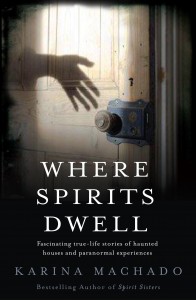
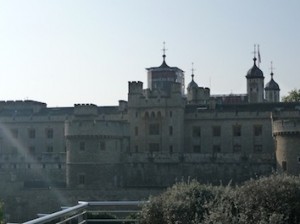
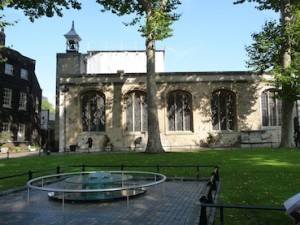

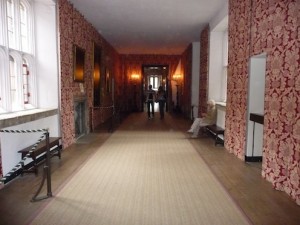

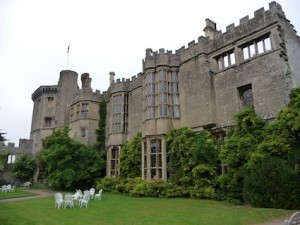
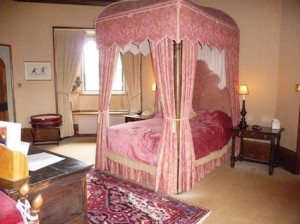
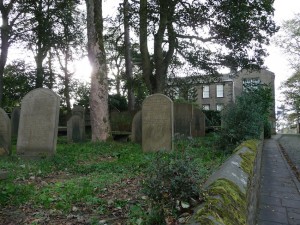
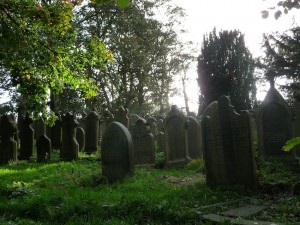















WOW. I hung on every word of this… beautifully written, I honestly felt like I was standing along side you. Looking forward to the novel! And making the tour feel like so far away…
Am so glad you enjoyed it Gemma! We will be in the UK before you know it x
Also loved the writing. Made me sad and hopeful at the same time.
Thank you for your lovely comment!
Loved this! We stayed in the Duke’s bedchamber just days after you did in 2009. My daughter who was 11 at the time barely slept all night and kept waking me up because she was frightened that Henry was going to haunt us as well.
I booked the room for the exact same reason, my love for Tudor history and Anne Bolyen. I can not wait to go back. I loved being in that bed chamber sitting in front of the fireplace!
I loved it too Michele! Thornbury is currently up for sale, I hope the person or persons that buy it appreciate the treasure it is. Fingers crossed
Wow!!! Started reading this article which led me to your very talented sister’s website!! Along side by interests in the Tudors is my love for the paranormal. You ladies have a wonderful gift. Thanks for sharing it with me. Looks like I have two more books to buy and read…..”Where Spirits Dwell” and “Spirit Sisters”. You two are keeping me very intrigued and busy…..Again, thanks soooooo much
Thank you Lois! I am off to my the book launch for ‘Where Spirits Dwell’ this evening. Very exciting!